

Last modified: 2004-12-28 by dov gutterman
Keywords: venezuela |
Links: FOTW homepage |
search |
disclaimer and copyright |
write us |
mirrors
See also:
This image was taken by the daily "El National" of
Caracas on the so called "Opposition March" last
Thursday. The addition on the flag take my attention.
Néstor Garrido, 16 October 2002
There is a phenomenon that recently has taken place in
Venezuela about the representations of the National Flag as
expression of feeling of a sector of the population that's
against the regime of president Hugo Chávez Frias. They are
variants or derivates of National flag without legal
effects. This doesn't mean that they are illegal even though
someone may be believe the opposite. Some flags have had a brief
existence because it have been merely circumstantial; others are
recurrent and possibly they will get to be Vexillological
Patrimony of Venezuela. According to our modest opinion they
aren't pure political flags because don't represent particular
political movements or parties: they are flags of social protest
because it express feelings of a national group against a
prevailing government system. Guillermo has called them
"Non-Political Opposition Flags. Guillermo has sent the ones
described by Marianella De Faria, joined with the one of the
sector that supports the Chavez' regime for your consideration.
Other variants also exist.
Raul Orta, 8 September 2003
I should stress that such flags that are used by Non-partisan
opponents of the Chavez Government. None of them seem to be
official, nor do they belong to a political party, in the modern
sense of the term.
Guillermo Aveledo, 8 September 2003
Opposition Flags
1)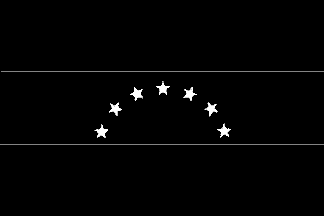
by Zachary Harden, 19 December 2004
Representation of the National flag in black and white (2002):
hoisted in subsequent manifestations to April 11th, 2002 as
mourning symbol.
Raul Orta, 8 September 2003
2)
by Guillermo Aveledo, 27 August 2003
Flag of Mourning (2002): Black field hoisted in subsequent
manifestations to April 11th, 2002.
Raul Orta, 8 September 2003
3)
by Zachary Harden, 19 December 2004
Flag of hurt and mourning (2002): hoisted in subsequent
manifestations to April 11th, 2002 as mourning symbol.
Raul Orta, 8 September 2003
4)
by Guillermo Aveledo, 27 August 2003
Flag for requesting Chavez' exit (2003): hoisted in
manifestations of the non-politics opposition during 2002 and
2003.
Raul Orta, 8 September 2003
5)
by Zachary Harden, 19 December 2004
This is Flag ZULU in the International Code of Signals.
Is this deliberate and what does it mean if it is?
Andre Burgers, 7 September 2003
Cuatricolor Flag (2003): hoisted during manifestations of the
group so called "Gente del Petróleo" (Petroleum
People) integrated by oil industry personnel affected by measures
taken by the Hugo Chávez' regime. It seems to be combination of
the National Flag colors with black, for symbolize protest and
mourning;
Raul Orta, 8 September 2003
6)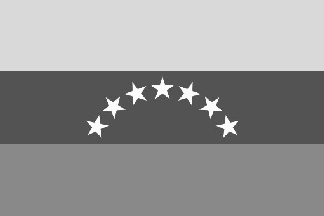
by Zachary Harden, 19 December 2004
Representation of National flag in white, gray and black
(2002): hoisted in subsequent manifestations to April 11th, 2002
as mourning symbol.
Raul Orta, 8 September 2003
Chavez Supporters
7)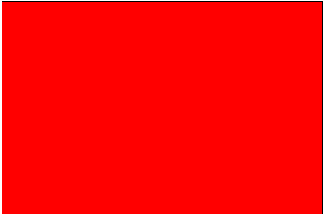
by Zachary Harden, 19 December 2004
Red Flag (2002-2003): hoisted by Chavez' partisans in
Government manifestations.
Raul Orta, 8 September 2003
Opposition Flags
1) 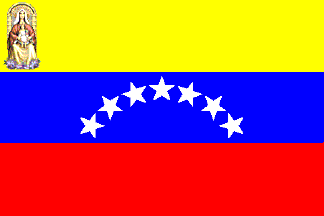
by Raul Orta and Ivan Sache, 12 June 2004
With image of Our Lady of Coromoto, Celestial Matron of
Venezuela, on the canton.
Raul Orta, 8 June 2004
2)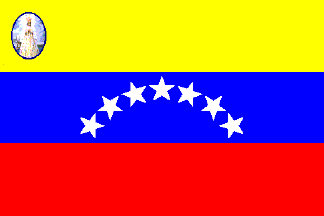
by Raul Orta and Ivan Sache, 12 June 2004
With image of Our Lady of Valle del Espiritu Santo (Holy
Ghost\rquote Valley), Celestial Matron of the Venezuelan Orient,
on the canton.
Raul Orta, 8 June 2004
3)
by Raul Orta and Ivan Sache, 12 June 2004
With image of Our Lady Mary Help of the Christians on the
canton.
Raul Orta, 8 June 2004
4) 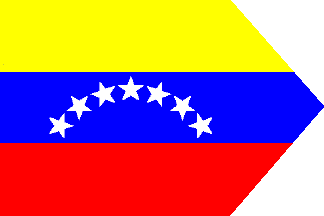
by Zachary Harden, 19 December 2004
In the recollection of signatures or "firmazo" for
Revocatory Referendum against President Chavez.
Raul Orta, 8 June 2004
5)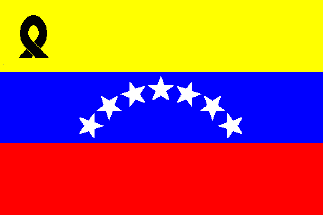
by Raul Orta and Ivan Sache, 12 June 2004
With black bow as mourning signal.
Raul Orta, 8 June 2004
Pro-government flags (President Chavez partisans)
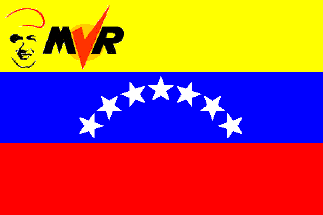
by Raul Orta and Ivan Sache, 12 June 2004
With logotype of Movimiento Quinta Republica (Fifth Republic
Movement) on the canton.
Raul Orta, 8 June 2004

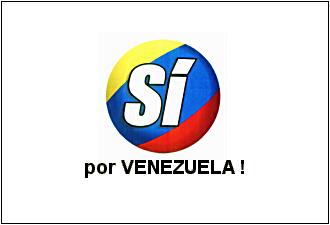
Initial version
by Raul Orta, 15 July 2004 and Zachary Harden,
19 December 2004

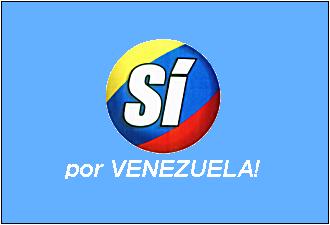
Latest version
by Raul Orta, 10 August 2004 and Zachary Harden,
19 December 2004
"RR" ("Revocatory Referendum"),
"NO" and "SI" (Yes)...
Naturally, partisans in favor to President’ s exit
("SI") as whom wish that he continues ("NO")
have expressed their aspirations in evident way: these ones have
chosen a red field with a white cartoon dialog-cloud contains the
word "NO" in red capital gothic letters, whereas those
ones have assumed as symbol a sphere reproducing National Flag on
which appears the word "SI" - eventually accompanied by
a sign of admiration too- in white gothic letters complementing
itself with the phrase "por Venezuela" (for Venezuela)
in black capital letters underneath the sphere, all over white
background.
Both designs also has been non-formally reproduced on Flags which
justifies also to consider it today as contemporary
vexillological pieces, tomorrow historical ones of Venezuela.
Now we would like to consider briefly its
semiological-symbollogical connotation. It ‘s obvious that
both concepts have been advertising products; but, both are in
net syntony with which try to express. Further that one or
another one have been fruit of the imposition, the necessity or
the spontaneity, is implicit in each case its message and the
more perhaps important still, its meta-message; mainly, with
regard to the Venezuela that each sector wishes that prevails
after August 15th.
Raul Orta, 15 July 2004
President Chavez is a left-winger, the red color is certainly
socialist, and we already records plain red flags being used by
his supporters.
Richard Knipel, 15 July 2004
The latest versions of the un-formal vexillography of the two
tendencies are reflected in the above images (second version): In
the "SI" one, blue alludes to Holiest Virgin whose
protection and help has been required by the Opposition Sector
whilst on the "NO" one was added the word
"VOTA" (Vote for).
Raul Orta, 10 August 2004

Colectivo Vargas Revolución
by Guillermo Aveledo, 30 August 2004

Bolivarian Circle of Baruta Municipality (?)
by Guillermo Aveledo, 30 August 2004

Iconography of Zamora
by Guillermo Aveledo, 30 August 2004
Jaume Olle sent a photo
of a meeting of the pro-governmental sector. I have been able to
identify one of them; the red-blue-red tricolour. This flag,
reproduced with the white border that showed on the photograph,
is from the "Colectivo Vargas Revolución", a
pro-Chavez, anti-MVR movement in Vargas state. The other
flag, which remains unidentified, seems to be that of a
Bolivarian Circle from the Municipio Baruta, in Caracas
Metropolitan District. The placing of a place's name to identify
the local branch of a national or regional political party is
common place. This would not be, however, the flag of a party
(none of the pro-government parties we have identified has such
imagery). On this particular flag, wehave an effigy of Ezequiel
Zamora, an XIXth Century civil war caudillor and one of the
historical figures ussualy evoked by the Chavismo movement. This
flag can be attributed to a local cell of the movement. According
to their website <www.circulosbolivarianos.org>
in the Municipio Baruta of Miranda state there are three
"Casas Bolivarianas del Poder Popular" (Bolivarian
Houses of People's Power), along the parishes of Baruta, Las
Minas and El Cafetal. Nonetheless, the Bolivarian Cricles
normally use a different symbol (I have never seen a flag, at
least a regularly used flag). Well, a logo, rather than a symbol:
they use three concentrical circles (red-blue-yellow) within
which they place an effigy of Simon Bolivar, using different
portraits. Zamora, together with Bolivar and Simon Rodrigez
(a.k.a. Simon Robinson, an early XIXth century pedagogue and
enligthened thinker) are the figures whose political proposals,
mixed metaphorically in the "Tree of the Three Roots",
are considered by Chavismo as the precursors of their ideology.
Zamora's image has been much more widely used than that of
Rodr?guez, as has been noted upon following other government
rallies, where flags as the one reproduced in ve}chavez!4.gif has
been reported. Moreover (in the case of the Chavismo, there is a
murky line between partisan flags and government organization's
colours. There is a current tendency to modify the colours and
emblems of government's ministries and agencies with the
Chavismo's red.
Guillermo Aveledo, 30 August 2004

by Guillermo Aveledo, 30 August 2004

by Guillermo Aveledo, 30 August 2004

by Guillermo Aveledo, 30 August 2004
The MVR party, however, has not
been the main staple of President Chavez movement. although it
holds a majority of governorships, and has the largest fraction
in the National Assembly, it has not been used by President
Chavez as the main instrument of his mass movement. Channelling
popular support through grass roots organizations directly linked
to the government, such as the Bolivarian Circles, many local pro
Chavez groups have appeared, using the movement colours (like top
image, which had an unusual tricolour) and crafting some designs
of their own. The previous post had two examples of that bearing
the image of Ezequiel Zamora. Another common example is the flag
portrayed in the second image. This yellow fielded flag bears an
uniform-wearing, beret-clad Chavez, printed in black, made from a
famous 1992 photograph. The upper hoist corner holds the name
"CHAVEZ" in capital yellow, black-bordered, letters;
and its lower side has the caption "UNICO LEADER"
("sole leader") in red. the Upper fly corner has a
black square mimicking the cover of the 1999 constitution.
More recently, the 2004 recall referendum campaign saw the
production of flyers and paper flags. The red colour has finally
positioned itself as the colour of choice of the MVR (no statutes
reflect this, though). In the bottom image, a red 2:1 field
bearing the name "Chávez" in white was widely
distributed. You can see how the letter "á", which as
an accent mark in the Spanish writing of the President's name,
mimics a beret. Sometimes, the Pro-government rallies
fashion the 1859 Barinas
Federation Flag, and the 1863
Venezuelan Flag, as an homage to the "Federal
Revolution" roots of the Chavista movement.
Guillermo Aveledo, 30 August 2004